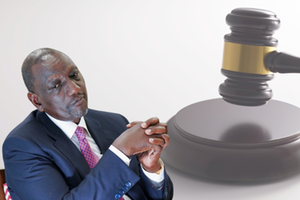International Women's Day : Numbers don’t lie, women still trail
What you need to know:
- The 2020 Economic Survey released by National Treasury Cabinet Secretary Ukur Yattani last year, for example, lifted the lid on how women trail men in leadership in many fields.
- Currently, out of the 349 seats in Parliament, only 76 members are female representing only a fifth of the total.
- Kenya’s founding President Mzee Jomo Kenyatta had no women in power.
Women’s participation in leadership in both in public and private sectors has lagged behind for decades.
Since independence, they have struggled and agitated for inclusion with little success despite the 2010 Constitution that emphasised on gender equality.
The 2020 Economic Survey released by National Treasury Cabinet Secretary Ukur Yattani last year, for example, lifted the lid on how women trail men in leadership in many fields.
According to the study, the number of women in key public decision-making positions for the period 2018 to 2019 was low compared to their male counterparts.
It showed Chief Administrative Secretaries (CAS) comprised 33.3 per cent of women in appointive decision-making positions in the public service in 2019.
Women County Executive Committee Members (CECM) declined marginally from 31.9 per cent in 2018 to 31.5 per cent in 2019.
Other women public officers in appointive positions held less than 30.0 per cent within their positions.
In the Judiciary, the proportion of women magistrates, however, increased from 46.6 per cent in 2018 to 53.3 per cent in 2019.
In the Judiciary, no woman has ever served as Chief Justice, President of the Supreme Court, or President of the Court of Appeal. There is not a single woman in the Kadhis’ Courts, religious courts adjudicated by Kadhi magistrates that apply a hybrid legal approach with Sharia Law.
One-third gender rule
For elective positions, only Members of County Assembly (MCAs) met the threshold of the one-third gender rule at 33.6 per cent, in 2019, with nine counties however not meeting the minimum one-third gender requirement.
Currently, out of the 349 seats in Parliament, only 76 members are female representing only a fifth of the total.
According to the Constitution, Parliament should at least have 117 female MPs and thus falls short by 41 members.
The Senate too, misses the mark with only 21 women owning seats instead of the 23 demanded by law.
Kenya’s political system lags behind its East African neighbours with women occupying only 23.5 per cent key positions across government bodies.
The 2017 election, however, represented a step forward for women’s representation. Compared to the elections in 2013, more women won seats at all levels, except for the presidential race, which remains exclusively male.
For the first time, women became governors and senators (three of each in 2017, compared to none in 2013), while more women were elected to the national and county assemblies (23 members of the national assembly in 2017 versus 16 in 2013, and 96 members of county assemblies in 2017 versus 82 in 2013.
Positive changes
Women running as independent candidates were also, for the first time, elected. While these are positive changes, women comprised just 9.2 per cent of the 1,835 elected individuals in 2017, a marginal increase from 7.7 per cent in 2013.
Only 20 per cent of the members of the 11th Parliament (2013-2017) were women, far below the required threshold.
At the executive level, women still lag behind with only seven female Cabinet Secretaries out of a cabinet of 23.
The current cabinet is, however, seen as an improvement compared to that of retired President Mwai Kibaki’s government.
After the 2002 general election that propelled Kibaki to power, the country for the first time, witnessed the appointment of three women cabinet ministers, three women assistant ministers, and four permanent secretaries.
Critics, however, faulted the move saying the number fell far short of the National Rainbow Coalition’s campaign promise of 30 per cent women representation in government.
The late retired President Daniel Moi’s team was not any better; the number of women at the Cabinet and assistant ministers during his tenure were minimal, with only Nyiva Mwendwa being appointed the first and only woman minister in 1995. Female assistant ministers were very few.
Observers, however, say Moi proved his soft spot for women when he also appointed Sally Kosgei as Head of Public Service in 2001, becoming the first women to hold such a position in Kenya.
He also made history when he appointed Lady Justice Effie Owuor as Kenya’s first woman High Court Judge in 1982.
Kenya’s founding President Mzee Jomo Kenyatta, had no women in power. His presidency from independence in 1963 to the time he died 15 years later on August 20, 1978, was defined by a masculine Cabinet. Jomo had no woman minister or assistant minister.
In academia, there are still fewer women in leadership positions. Despite gains made regarding the inclusion of women in higher education, they continue to be under-represented, particularly in senior management positions in State universities
With more than 50 private and public universities in the country, the number of women vice-chancellors is not more than 10.
Female vice-chancellors
This is, however, an improvement compared to from 1960 to 1990s when there was not a single woman vice-chancellor in the country.
Lack of women’s participation in academic leadership is, however, not limited only to Kenya, but a continental and global problem.
Out of the 1,500 universities in the continent, only 40 are headed by female vice chancellors. The figures don’t hold well beyond African borders too. Globally, only 34 of the top 200 universities, have women at the helm.
In the private sector, things are not rosy either. A report on gender equality at the workplace released in November 2019, brought to the fore the sad reality of how women still lag behind in Kenya’s corporate management, with only 22 per cent representation.
According to the report launched by the Nairobi Securities Exchange (NSE), Equileap and New Faces New Voices, of the 60 companies listed on the NSE, only seven are headed by women.
No firm had achieved gender balance at the board, executive, senior management and general workforce levels. Globally, men occupy approximately 80 per cent of board seats and more than 13 per cent of companies having an all-male board.
In 2019, slightly more than one-third (36 per cent) of global boards had at least three women, up from 32 per cent in 2018.
An analysis of more than 8,600 companies in 49 countries showed women held 16.9 per cent of all global board seats in 2018, up from 15 per cent in 2016.
As of October 2018, women held 26.7 per cent of board seats in the largest publicly listed companies in European Union member states.
Women comprised 6.7 per cent of board chairs in 2018, which more than doubled from 3.3 percent in 2012.
Research done by the International Labour Organisation (ILO) indicates boardrooms with 30 to 39 per cent women are 18.5 per cent more likely to have improved business outcomes.
In churches, women are still not adequately involved in leadership. Insiders share that although women in some churches have vied for various leadership positions, none has ever been successful.
The tide seems to have changed a bit following the appointment of Ms Emily Onyango as Assistant Bishop in the Diocese of Bondo. She became the first female Anglican bishop in East and Central Africa, a sign for better things to come.





